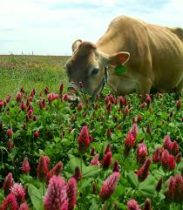Cover crops are known to protect soil and water quality, but they also can offer valuable livestock feed, according to Iowa State University research.
Until now, there’s been little reliable, Iowa-based information to assess the value and viability of cover crop feedstock for Iowa’s cattle industry, which represents an estimated $4-6 billion of economic activity in the state, the university said.
A new study is helping answer questions about the practice, with support from the Iowa Nutrient Research Center and the Leopold Center for Sustainable Agriculture at Iowa State.
“Our goal is to be able to tell producers: ‘This is about what you can expect on average, and this also is the variability you might see,’” said Dan Loy, director of the Iowa Beef Center at Iowa State, one of the lead researchers. “The preliminary data are encouraging, even with some pretty dramatic variations in weather and cover crop growth that we’ve experienced at our study sites.”
Five research plots at three Iowa State research farms were selected for the study to reflect weather and soil conditions around the state. There are three plots on the McNay Memorial Research Farm in Lucas County, and one each at the Allee Memorial Demonstration Farm in Buena Vista County and the Western Research & Demonstration Farm in Monona County.
Plot treatments include grazed cover crops of cereal rye and oats interseeded into standing corn or soybeans, ungrazed cover crop and no cover crop, the university said. Researchers are evaluating forage yield and quality, growing cattle performance and soil health.
The early findings confirm that forage yields vary widely from year to year, due to field location, weather patterns and planting dates, the researchers reported. Spring biomass yields of cereal rye for 2016-18 ranged from an average of about 800 to almost 2,900 lb. of dry matter per acre at different McNay plots, and about 800 lb. per acre at the Allee and Western plots. While in some years the forage yield per acre was nearly 4 tons (dry matter) per acre following corn silage, in other years, the forage yield was less than 200 lb. of dry matter per acre when following full season corn and beans, according to Iowa State.
In 2018, the first year for the addition of the fall grazing component in the study, weather conditions made it challenging to establish a cover crop. As a result, fall forage biomass from a cover crop mix of cereal rye and oats ranged from fewer than 100 lb. of dry matter per acre up to 1,675 lb. per acre on the same farm, with mid-yielding plots around 730 lb. per acre at McNay and approximately 340 lb. per acre at both the Allee and Western farms, Iowa State said.
On a good year, at stocking rates of about 1.5 head of cattle per acre, the cereal rye cover crop offered 20-27 days of spring grazing, the researchers said, while in the fall, the cereal rye and oat cover crop mix provided suitable grazing for 8-13 days. Other years, such as 2018, the spring weather conditions were unfavorable for grazing.
Preliminary data on cattle performance suggests that weight gain is similar for stocker cattle grazed on cover-crops compared to cattle grazing on pasture.
“Economics can be volatile in the cattle industry, as with most commodities,” Loy said. “Cost control can be extremely important, and stored feed cost is the biggest cost of production. If cattle graze even for a short time, it can improve the bottom line.”
Livestock producers who don’t already graze are often uncertain about adding new water and fencing, said Erika Lundy, an extension and outreach beef specialist and research team leader. One way to benefit without creating new infrastructure for grazing is to harvest the cover crop as silage or hay to extend winter feed supplies or to sell. Farmers without cattle might sell rights to custom graze or harvest in the late fall or spring.
Extension field agronomist Rebecca Vittetoe is coordinating aspects of the study looking at how the grazing of cover crops may affect soil health and soil compaction. It’s too soon to tell the long-term impacts on soil carbon from grazing cover crops, she said, but preliminary bulk density tests that measure compaction levels are encouraging.
“It looks like this system can potentially work well, as long as cattle stocking rates are reasonable and producers manage grazing based on environmental conditions,” Vittetoe said. To avoid problems, she recommended producers take livestock off fields during especially wet periods where the cattle will cause more compaction issues and “soil surface roughness” that could hamper planting next year’s cash crop — especially corn, which is more sensitive to planting depth.
Managing herbicides is one of the most challenging aspects of using cover crops for cattle feed, according to the researchers.
“Livestock producers should plan ahead and consider label restrictions on herbicides and other pesticides used earlier in the growing season if they want to use a cover crop for forage,” Vittetoe said. “Herbicide and pesticide residues may prevent successful establishment of the cover crop, and many herbicides used for soybeans would prevent using the cover crop for feed.”
To guide producers, Vittetoe and colleagues have developed an Extension bulletin that covers many common herbicides.
The Iowa Nutrient Research Center project continues through spring 2020. When completed, the researchers plan to highlight their findings in a fact sheet. In the meantime, preliminary information is being presented at outreach events. The data is also being used to help calibrate the stocker module of the Beef Ration & Nutrition Decision Software (BRANDS).





Post a comment
Report Abusive Comment